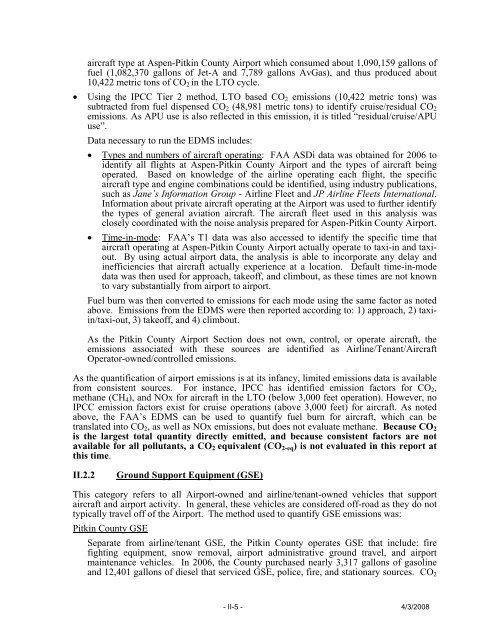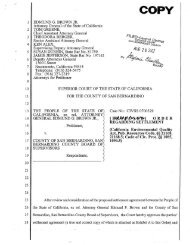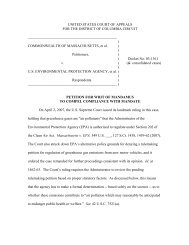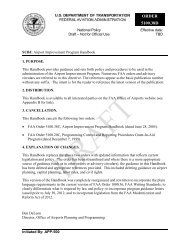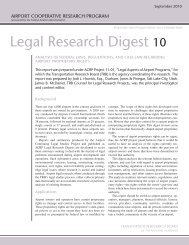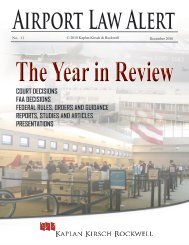Aspen-Pitkin County Airport Greenhouse Gas Emissions Inventory ...
Aspen-Pitkin County Airport Greenhouse Gas Emissions Inventory ...
Aspen-Pitkin County Airport Greenhouse Gas Emissions Inventory ...
You also want an ePaper? Increase the reach of your titles
YUMPU automatically turns print PDFs into web optimized ePapers that Google loves.
aircraft type at <strong>Aspen</strong>-<strong>Pitkin</strong> <strong>County</strong> <strong>Airport</strong> which consumed about 1,090,159 gallons offuel (1,082,370 gallons of Jet-A and 7,789 gallons Av<strong>Gas</strong>), and thus produced about10,422 metric tons of CO 2 in the LTO cycle.• Using the IPCC Tier 2 method, LTO based CO 2 emissions (10,422 metric tons) wassubtracted from fuel dispensed CO 2 (48,981 metric tons) to identify cruise/residual CO 2emissions. As APU use is also reflected in this emission, it is titled “residual/cruise/APUuse”.Data necessary to run the EDMS includes:• Types and numbers of aircraft operating: FAA ASDi data was obtained for 2006 toidentify all flights at <strong>Aspen</strong>-<strong>Pitkin</strong> <strong>County</strong> <strong>Airport</strong> and the types of aircraft beingoperated. Based on knowledge of the airline operating each flight, the specificaircraft type and engine combinations could be identified, using industry publications,such as Jane’s Information Group - Airline Fleet and JP Airline Fleets International.Information about private aircraft operating at the <strong>Airport</strong> was used to further identifythe types of general aviation aircraft. The aircraft fleet used in this analysis wasclosely coordinated with the noise analysis prepared for <strong>Aspen</strong>-<strong>Pitkin</strong> <strong>County</strong> <strong>Airport</strong>.• Time-in-mode: FAA’s T1 data was also accessed to identify the specific time thataircraft operating at <strong>Aspen</strong>-<strong>Pitkin</strong> <strong>County</strong> <strong>Airport</strong> actually operate to taxi-in and taxiout.By using actual airport data, the analysis is able to incorporate any delay andinefficiencies that aircraft actually experience at a location. Default time-in-modedata was then used for approach, takeoff, and climbout, as these times are not knownto vary substantially from airport to airport.Fuel burn was then converted to emissions for each mode using the same factor as notedabove. <strong>Emissions</strong> from the EDMS were then reported according to: 1) approach, 2) taxiin/taxi-out,3) takeoff, and 4) climbout.As the <strong>Pitkin</strong> <strong>County</strong> <strong>Airport</strong> Section does not own, control, or operate aircraft, theemissions associated with these sources are identified as Airline/Tenant/AircraftOperator-owned/controlled emissions.As the quantification of airport emissions is at its infancy, limited emissions data is availablefrom consistent sources. For instance, IPCC has identified emission factors for CO 2 ,methane (CH 4 ), and NOx for aircraft in the LTO (below 3,000 feet operation). However, noIPCC emission factors exist for cruise operations (above 3,000 feet) for aircraft. As notedabove, the FAA’s EDMS can be used to quantify fuel burn for aircraft, which can betranslated into CO 2 , as well as NOx emissions, but does not evaluate methane. Because CO 2is the largest total quantity directly emitted, and because consistent factors are notavailable for all pollutants, a CO 2 equivalent (CO 2-eq ) is not evaluated in this report atthis time.II.2.2Ground Support Equipment (GSE)This category refers to all <strong>Airport</strong>-owned and airline/tenant-owned vehicles that supportaircraft and airport activity. In general, these vehicles are considered off-road as they do nottypically travel off of the <strong>Airport</strong>. The method used to quantify GSE emissions was:<strong>Pitkin</strong> <strong>County</strong> GSESeparate from airline/tenant GSE, the <strong>Pitkin</strong> <strong>County</strong> operates GSE that include: firefighting equipment, snow removal, airport administrative ground travel, and airportmaintenance vehicles. In 2006, the <strong>County</strong> purchased nearly 3,317 gallons of gasolineand 12,401 gallons of diesel that serviced GSE, police, fire, and stationary sources. CO 2- II-5 - 4/3/2008


